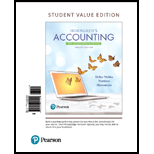
1)
a)
• Bonds are long term negotiable instruments of debt issued by corporate entities to secure funds from the public.
• These funds are used to either fund long term capital expenditure or similar long term investment opportunities.
• Bonds represent steady income for the investor in the form of periodic interest payments by the entity issuing the bond. Bonds are issued at par, at premium or at a discount.
• Bond Price is the maximum price that an investor will pay for a bond. It is calculated as the present value of the bond.
Price of $100000, 8% bond issued at 75.25.
b)
Bond Price
• Bonds are long term negotiable instruments of debt issued by corporate entities to secure funds from the public.
• These funds are used to either fund long term capital expenditure or similar long term investment opportunities.
• Bonds represent steady income for the investor in the form of periodic interest payments by the entity issuing the bond. Bonds are issued at par, at premium or at a discount.
• Bond Price is the maximum price that an investor will pay for a bond. It is calculated as the present value of the bond.
Price of $100000, 8% bond issued at 103.50
c)
Bond Price
• Bonds are long term negotiable instruments of debt issued by corporate entities to secure funds from the public.
• These funds are used to either fund long term capital expenditure or similar long term investment opportunities.
• Bonds represent steady income for the investor in the form of periodic interest payments by the entity issuing the bond. Bonds are issued at par, at premium or at a discount.
• Bond Price is the maximum price that an investor will pay for a bond. It is calculated as the present value of the bond.
Price of $100000, 8% bond issued at 94.50
d)
Bond Price
• Bonds are long term negotiable instruments of debt issued by corporate entities to secure funds from the public.
• These funds are used to either fund long term capital expenditure or similar long term investment opportunities.
• Bonds represent steady income for the investor in the form of periodic interest payments by the entity issuing the bond. Bonds are issued at par, at premium or at a discount.
• Bond Price is the maximum price that an investor will pay for a bond. It is calculated as the present value of the bond.
Price of $100000, 8% bond issued at 103.25
2)
Retirement of Bonds
• When a bond is issued at a discount or at premium or at face value, the amount to be repaid as the principal amount is the face value of the bonds.
• When a bond is issued at a discount, the difference between the issue price and the face value is the cost to be borne by the company.
• Bonds are issued at a discount when the stated rate of interest is less than the market rate of interest.
Which of the bonds will have maximum
Want to see the full answer?
Check out a sample textbook solution
Chapter 14 Solutions
Horngren's Accounting: The Managerial Chapters, Student Value Edition (12th Edition)
- Which method of inventory valuation assumes that the earliest goods purchased are sold first?a) FIFOb) LIFOc) Weighted Averaged) Specific Identificationdont use aiarrow_forwardPlease provide the answer to this financial accounting question using the right approach.arrow_forwardIdentify and explain three itemized deductions that are available to taxpayers. Are there any that you would add and if so, which ones?arrow_forward
- Elegant Furnishings earned net sales revenue of $42,375,000 in 2023. The cost of goods sold was $29,662,500, and net income reached $7,800,000, the company's highest ever. Compute the company's gross profit percentage for 2023.arrow_forwardDepreciation is classified as a(n):a) Assetb) Expensec) Liabilityd) Revenuearrow_forwardStrudel Company reported 2008 sales ($ in millions) of $4,825 and a cost of goods sold of $3,560. The company uses the LIFO method for inventory valuation. It discloses that if the FIFO inventory valuation method had been used, inventories would have been $86.3 million and $71.8 million higher in 2008 and 2007, respectively. If Strudel used the FIFO method exclusively, it would have reported 2008 gross profit closest to? A. $1,265.0 million B. $1,279.5 million C. $1,351.3 millionarrow_forward

 AccountingAccountingISBN:9781337272094Author:WARREN, Carl S., Reeve, James M., Duchac, Jonathan E.Publisher:Cengage Learning,
AccountingAccountingISBN:9781337272094Author:WARREN, Carl S., Reeve, James M., Duchac, Jonathan E.Publisher:Cengage Learning, Accounting Information SystemsAccountingISBN:9781337619202Author:Hall, James A.Publisher:Cengage Learning,
Accounting Information SystemsAccountingISBN:9781337619202Author:Hall, James A.Publisher:Cengage Learning, Horngren's Cost Accounting: A Managerial Emphasis...AccountingISBN:9780134475585Author:Srikant M. Datar, Madhav V. RajanPublisher:PEARSON
Horngren's Cost Accounting: A Managerial Emphasis...AccountingISBN:9780134475585Author:Srikant M. Datar, Madhav V. RajanPublisher:PEARSON Intermediate AccountingAccountingISBN:9781259722660Author:J. David Spiceland, Mark W. Nelson, Wayne M ThomasPublisher:McGraw-Hill Education
Intermediate AccountingAccountingISBN:9781259722660Author:J. David Spiceland, Mark W. Nelson, Wayne M ThomasPublisher:McGraw-Hill Education Financial and Managerial AccountingAccountingISBN:9781259726705Author:John J Wild, Ken W. Shaw, Barbara Chiappetta Fundamental Accounting PrinciplesPublisher:McGraw-Hill Education
Financial and Managerial AccountingAccountingISBN:9781259726705Author:John J Wild, Ken W. Shaw, Barbara Chiappetta Fundamental Accounting PrinciplesPublisher:McGraw-Hill Education





